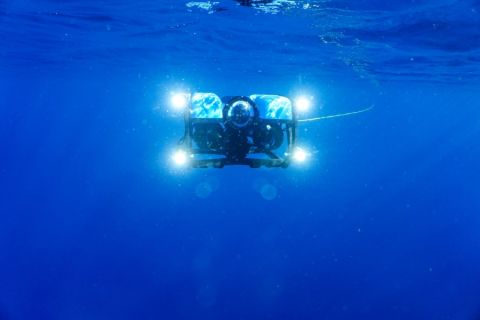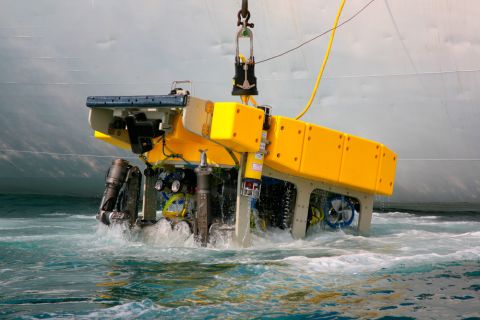It is widely acknowledged that current subsea well intervention methods are a necessary but time consuming and costly activity, with rig costs running up to US $1 million a day. There are approximately 4,000 oil and gas producing subsea wells across the globe, and this number is increasing. With many now more than a decade old, these wells require servicing to allow for maximum oil and gas recovery.
This challenge has come to the fore in recent years with the sustained rise of deepwater oil and gas exploration. The inherent harsh conditions experienced at great depths offshore Brazil, Asia, and West Africa, and in the Gulf of Mexico mean a well could have been producing for 10 years without intervention. This often results in suboptimum production and ultimate recovery.

Expro, Deep Tek, and Parkburn developed a fiber rope umbilical bundle and handling system for deploying the AX-S system. (Images courtesy of Expro)
Meeting demands
To address these issues, it was clear that a step-change in technology was required. After a seven-year development program involving the technical expertise of a range of partner companies, Expro has developed the AX-S (“access”) system, which will provide a safe, riserless, remotely operated subsea well intervention solution costing significantly less than a rig-based alternative. The system, which is deployed from a monohull vessel, is the first intervention technology that can operate efficiently at depths to 10,000 ft (3,000 m), which covers every subsea well in the world. It allows operators to significantly increase production rates and ultimate recovery from subsea wells. The AX-S system has been designed and built by technical leaders in many fields with the input of more than 200 vendors, including Parkburn Precision Handling Systems, Schilling Robotics, Hydrafit Subsea Solutions, TS Marine Asia Pacific, and Deep Tek Ltd.
Expro, Deep Tek, and Parkburn have developed a fiber rope umbilical bundle and handling system for deploying the AX-S system. This comprises three individual umbilicals helically wrapped around a main fiber rope, which provides greater strength and operational efficiency than wire rope alternatives. It is buoyant in water and, therefore, adds no additional weight to the overall deployment system. This also reduces the winch power consumption. Additionally, there is no torque in the lifting line that could prove hazardous in the management of vessel-based operations.
The technology also brings benefits in the safety aspect of its design. As the tool swaps are carried out on the seabed, back deck operations are far safer. Also, it is only necessary to disconnect the running tool and control umbilical from the supporting vessel to leave location, leaving the system as a fully pressure-containing safety barrier on top of the subsea tree.
Partnering for success
According to Andy Lawson, managing director of Parkburn, “Building the handling system for AX-S has developed into the single largest-scale project for Parkburn, both financially and technically.” Parkburn has been involved in many large projects, he said, but this has surpassed them all.
“We have more than 40 people engaged directly on this project between design, manufacturing, and administration, but through the supply chain, this could easily expand to more than 200 and covers many countries.”
The process of working on the AX-S project has evolved through three basic stages, Parkburn said:
• Phase 1 has encompassed conceptual development of the technology and solutions;
• Phase 2 has included detailed design and manufacturing;
• Phase 3 has moved toward dockside mobilization to be followed by ultimate installation on a selected vessel.

The AX-S structure is 110 ft (33.5 m) tall, weighs 220 metric tons, and is rated for operations to 10,000 ft water depth and 21,982 ft (6,700 m) in-well depth.
“Through the process, there have been a number of different technical approaches and solutions from stern to moonpool deployment, plus looking at various vessels and adapting the design to suit,” Parkburn said, noting that though the process was technically challenging, the “feel” always has been good and the satisfaction high. “There have been many highlights of this project,” Parkburn said. “Obviously seeing the designs developed into manufactured components is a major buzz, particularly the fiber rope drum winch, winder, and tower aligned with the subsea package development by Expro.”
The combination of Deep Tek’s extensive operational experience in deepwater salvage using fiber rope and its winder concepts, coupled with Parkburn’s wide marine handling experience in design and manufacturing, allied with AX-S’s deepwater intervention technology and developments.
“We certainly feel this combination has turned concept into reality and taken the project to be streets ahead of anything in the market today,” Parkburn said.
ROV charter
Expro also recently has entered into a multiyear charter party contract with TS Marine Asia Pacific to supply a vessel, ROV, and other associated services to support deployment of the system.
The contract will see Expro use the DP-2 multiservice vessel Havila Phoenix in conjunction with the AX-S system for worldwide operations. The Havila Phoenix is 361 ft (110 m) long and 75 ft (23 m) wide with a moonpool of 24 ft by 24 ft (7.2 m by 7.2 m), a 250-metricton actively heave-compensated subsea crane, and two 13,123-ft (4,000-m) rated Schilling UHD workclass ROV systems.
According to John Edwards, TS Marine Asia Pacific’s CEO, “TS Marine is very pleased to enter into this important contract with Expro and the AX-S technology. We believe we will prove the ideal partner for Expro’s well intervention strategy by combining our integrated services of vessel, ROV, subsea positioning, and marine operations with our own well intervention experience from ongoing operations in Asia Pacific.”
DNV also has been heavily involved in the process, independently providing hazard assessment and technical qualification throughout the development and testing program.
Such a process at every step of development is critical to mitigating the technical and operational risk of such a groundbreaking project.
The system
The AX-S structure is 110 ft (33.5 m) tall, weighs 220 metric tons, and is rated for operations to 10,000 ft water depth and 21,982 ft (6,700 m) in-well depth. It is deployed onto a subsea tree with an active heave-compensated fiber winch from a monohull vessel and is remotely controlled from the surface like an ROV.
The structure consists of an integrated set of pressure-contained subsea packages comprising a well control package, tool storage package, wireline winch package, and fluid management package. A hydraulic plug-pulling tool overcomes the risks associated with pulling and setting tree crown plugs, and a novel control umbilical tackles the challenges of weight and subsequent deployment/ handling system size.
The system is more cost-effective than riser-based alternatives because it is supported from a monohull vessel and is faster to operate than wirethrough- water solutions, especially on horizontal trees.
The AX-S is an economically attractive option for wireline intervention in deepwater wells.
Recommended Reading
US Oil, Gas Rig Count Falls to Lowest Since January 2022
2024-05-03 - The oil and gas rig count, an early indicator of future output, fell by eight to 605 in the week to May 3, in the biggest weekly decline since September 2023.
Pemex Reports Lower 2Q Production and Net Income
2024-05-03 - Mexico’s Pemex reported both lower oil and gas production and a 91% drop in net income in first-quarter 2024, but the company also reduced its total debt to $101.5 billion, executives said during an earnings webcast with analysts.
Chouest Acquires ROV Company ROVOP to Expand Subsea Capabilities
2024-05-02 - With the acquisition of ROVOP, Chouest will have a fleet of more than 100 ROVs.
SLB, OneSubsea, Subsea 7 Sign Collaboration Deal with Equinor
2024-05-02 - Work is expected to begin immediately on Equinor’s Wisting and Bay Du Nord projects.
SilverBow Makes Horseshoe Lateral in Austin Chalk
2024-05-01 - SilverBow Resources’ 8,900-foot lateral was drilled in Live Oak County at the intersection of South Texas’ oil and condensate phases. It's a first in the Chalk.




